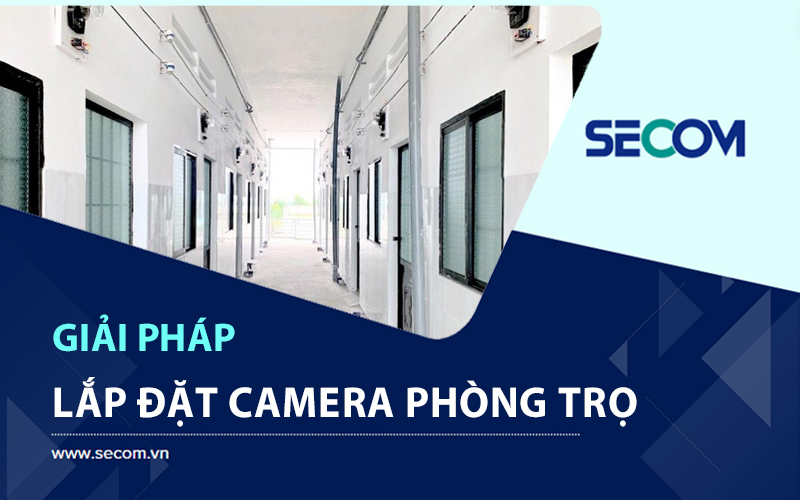- Security Solutions
- Oct. 15, 2024
Advice on Installing the Best Home Security Camera for 2024
Installing surveillance cameras is an optimal solution to prevent security risks and ensure the safety of family members. To achieve effective monitoring and comprehensive coverage, many people seek consultation services for installing home security cameras. So, what are the best home surveillance cameras? In this article, SECOM explores the criteria, installation experiences, and top-rated surveillance cameras currently available.
The Demand for Home Camera Installation Today
In recent years, the demand for home camera installation has increased significantly due to growing concerns about security. To reduce the risk of theft and illegal intrusion, many people have installed home surveillance cameras to protect their assets and ensure the safety of their family members. These devices help monitor the entire area around the house, detect unusual movements, and send real-time alerts to smartphones, allowing timely detection and response to incidents. Additionally, installing home security cameras can also help parents keep an eye on children or elderly family members, providing peace of mind when away from home.
To meet the demand for home surveillance, manufacturers have introduced a wide range of camera models with various designs, features, and capabilities. When choosing the right surveillance camera, you can consider your intended use, personal budget, or seek advice from reputable security companies.
Criteria for Choosing the Best Home Surveillance Camera
When selecting a home surveillance camera, it’s important to consider various factors such as image quality, features, and durability to find the most suitable device. Here are the key aspects to consider:
Image Quality
A camera with a high resolution will provide clearer and more detailed images, making it easier to identify people or events in the monitored area. Currently, the average resolution for home cameras ranges from 720p to 1080p. If you are installing cameras in dark areas or want to clearly see faces or license plates, opt for systems with higher resolutions, such as 1080p to 4K.
Field of View
For areas like living rooms, hallways, or yards, a camera with a field of view of 90 degrees or more is recommended. However, if you need to monitor larger areas, such as gardens, garages, or the entire living space, consider wide-angle cameras, long-range models, or those with 360-degree rotation capabilities to enhance coverage.
Additional Features
Besides image quality and viewing angles, smart features can enhance the effectiveness of monitoring:
- Infrared Technology: Allows the homeowner to observe areas day and night or in low-light conditions with clear image quality.
- Night Vision: Lets you monitor and record events at night, providing a clear view of what is happening.
- Motion Detection: Automatically records and sends alerts when unusual movement is detected in the surveillance area.
- Mobile Alerts: Some security cameras are equipped with notification features that send alerts to your phone, enabling timely detection and response to incidents.
- Wide Dynamic Range (WDR): Improves image quality by enhancing contrast and balancing light levels across different areas within the frame.
Durability
Apart from the above criteria, it’s essential to consider the durability of the device when choosing a home camera solution. Prioritize cameras designed to be dustproof, waterproof, and capable of operating well under various weather conditions to ensure effective surveillance.
Which Home Security Camera Should You Choose?
Choosing a home surveillance camera system depends on various factors, such as your needs, installation location, and budget. Each security camera type has its unique features, advantages, and disadvantages. Consulting with a security service provider can help you select the most suitable device. Here are some popular camera types and their pros and cons to help you make an informed decision.
Wired Cameras
Wired cameras are traditional devices suitable for households that want a fixed and large-scale surveillance system. These cameras transmit data via network cables or coaxial cables to a recording device.
Advantages:
- Fast Signal Transmission: Wired cameras provide stable and lag-free video transmission since they use direct cable connections.
- High Resolution: These cameras offer high-resolution images (1.0 – 5.0MP), making it easier to identify people and objects in the monitored area.
- Smart Features: Many wired models come with advanced technologies like motion detection, alerts, and zoom functions for better security management.
- High Security: Wired cameras are less susceptible to data breaches compared to Wi-Fi cameras.
Disadvantages:
- Complex Installation: The setup process requires running electrical and signal cables, which can be time-consuming and may need professional help.
- Limited Flexibility: Relocating wired cameras is inconvenient because of the attached cables, requiring reinstallation if moved.
Wireless Cameras
Wireless cameras connect to a Wi-Fi network, allowing you to monitor the area through a camera app on your smartphone.
Advantages:
- Mobile Alerts: The camera can send alerts directly to your phone whenever it detects unusual movements.
- Wide Field of View: Wireless cameras often have 360-degree views, making it easy to monitor the area with realistic, high-quality images.
- Two-Way Audio: Equipped with a microphone and speaker, allowing you to communicate directly with family members or issue warnings to intruders.
Disadvantages:
- Dependent on Wi-Fi: If the Wi-Fi signal is weak or disconnected, the surveillance system may be disrupted.
- Vulnerability to Hacking: Wireless connections can be targeted if the Wi-Fi network is not secure.
360-Degree Cameras
360-degree cameras provide comprehensive surveillance from a single location, making them a worthy choice for home security.
Advantages:
- Wide Viewing Angle: Offers full coverage of the surrounding area, reducing the number of cameras needed.
- High-Quality Images: Provides clear, detailed footage.
- Durable: Resistant to water and dust, suitable for outdoor use under various weather conditions.
Disadvantages:
- High Cost: These cameras tend to be more expensive than regular models.
- Internet Dependent: Image quality may vary based on the network connection’s stability.
Infrared Cameras
Infrared cameras use infrared lights to capture clear images even in low-light conditions.
Advantages:
- Excellent Night Vision: Captures clear images in darkness.
- Effective Night Surveillance: Provides broad, clear coverage for nighttime security.
- Affordable: Generally, infrared cameras are cost-effective compared to other types.
Disadvantages:
- Limited Color Display: Usually captures images in black and white or green at night.
- Affected by Bright Lights: Strong light sources can cause glare or reduce image quality.
IP Cameras
IP (Internet Protocol) cameras are advanced devices that record high-resolution images and transmit data over the internet.
Advantages:
- High Resolution: Delivers clear, vivid images.
- Remote Access: Supports remote monitoring via mobile devices.
- Simple Setup: Easy to install with just an internet connection.
- WDR (Wide Dynamic Range) Technology: Balances light levels in dark or bright areas.
Disadvantages:
- High Price: Typically more expensive than other camera types.
- High Bandwidth Usage: Requires more internet bandwidth and storage capacity.
- Internet Dependent: Needs a stable network connection for optimal performance.
Preparing to Install Home Cameras
Before installing a home camera system, gather essential equipment and accessories for effective operation:
- Camera Unit: The camera is the core component that captures images and transmits data.
- Recording Device: Usually comes with different ports (Video Output, Video Input, RJ45, Audio Input, Audio Output).
- Storage (Hard Drive): Stores recorded footage for later viewing.
- Accessories: Include power supplies, signal cables, connectors, etc.
- Monitoring Devices: Can be managed via smartphone, tablet, or laptop using specific apps or software.
Carefully considering your needs and the camera features will help you select the best surveillance system for your home.
Detailed Guide on Installing Home Security Cameras
Each surveillance device has different features and methods for installation, so it is essential to follow the correct procedures for each type to ensure the system operates effectively. Below is a guide on how to install both wired and wireless home security cameras:
How to Install Wired Home Surveillance Cameras
To install wired cameras safely and effectively, follow these steps:
- Choose an appropriate location: Select suitable positions for camera installation to cover both indoor and outdoor spaces.
- Pick a spot for the recorder and monitor: Choose an area to place the recording device and monitor. For larger premises like restaurants, shops, or parking lots, the recorder can be located in a dedicated surveillance room for easy monitoring.
- Run power cables: Connect power cables from the monitoring room to the camera location. Cables can be routed along corners or ceilings to maintain the aesthetic of the area.
- Mount the camera: Use a drill to secure the surveillance camera to the wall or ceiling, and consider using a junction box to cover cable connections.
- Connect the signal cables: Attach the signal cables to the camera to activate the system.
- Check camera angles: Turn on the camera monitoring app on your phone to adjust the camera angle if necessary.
Note: The process for installing wired cameras is relatively complex, so it’s best to consult with professional security installation companies for optimal solutions.
How to Install Wireless Home Surveillance Cameras
Here are the steps for setting up wireless surveillance cameras:
- Survey the area: Inspect the area where you plan to install the camera. It’s best to choose high positions without blind spots for comprehensive coverage. You may also consult a professional for advice.
- Connect the camera’s power source: Ensure the power cable is long enough to reach the camera installation site.
- Install the WiFi camera app on your phone: Scan the QR code on the system.
- Connect to WiFi and set up the password: Start monitoring using your phone.
- Mark mounting points: Use the camera’s base to mark spots before drilling.
- Secure the camera base with screws: Then attach the camera to complete the setup.
How Much Does It Cost to Install Home Surveillance Cameras?
In addition to functions and supplementary features, the cost of installing home security cameras is a top concern. The installation cost depends on various factors such as the type of camera, quantity, and service provider.
To ensure stable camera operation and long-range vision, homeowners should choose reputable installation companies like SECOM. As a leading security solutions provider from Japan, SECOM offers diverse security services at reasonable prices. Contact us today for a detailed consultation on camera installation.
Tips for Installing Home Security Cameras
Installing a home surveillance system is crucial for protecting assets and ensuring security. For an effective and durable system, consider the following tips:
- Determine the purpose: Knowing the intended use will help you choose the right camera type and location. Ask questions like whether you need indoor or outdoor cameras, or if they are for theft prevention or child monitoring.
- Location: Experts recommend prioritizing important areas such as windows, main doors, living rooms, and backyards.
- Camera type: Choose high-resolution cameras with good recording capabilities and stable network connections.
- Security measures: Change the default password, update the firmware regularly, and only grant access to trusted individuals.
- Compatibility: After installation, check features like video recording, motion detection, and alerts to ensure the system is compatible with the recorder.
- Brand: If you are unsure which type of camera to use, opt for reliable brands to guarantee quality.
Comprehensive Home Surveillance System Installation Services at SECOM
Recognizing the importance of home cameras for safety, SECOM offers professional and complete home surveillance installation services. With over 60 years of experience, we provide smart, flexible, and effective installation solutions tailored to customers’ security needs.
Our well-trained staff offer expert consultation on selecting the best camera types for optimal monitoring. Additionally, SECOM provides guidance on operation, maintenance, and attractive after-sales policies for customers using our services.
Installing a home surveillance system not only safeguards assets but also ensures the safety of family members. However, for the system to function effectively, it is important to carefully consider camera selection and installation. For affordable yet high-quality home camera installation advice, contact SECOM for support and a quick quote.

























